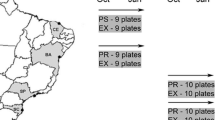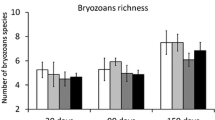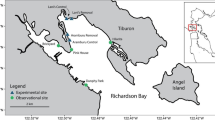Abstract
Of the suite of species interactions involved in biotic resistance to species invasions, predation can have complex outcomes according to the theoretical and empirical framework of community ecology. In this study, we aimed to determine the likelihood of consumptive biotic resistance within fouling communities in four ports of central Chile. Notably, we examined the influence of micro- (> 1–2 mm, < 1–2 cm) and macro- (> 1–2 cm) predators, with a particular focus on their effects on non-indigenous species (NIS). Experimental and observational approaches were combined. An exclusion experiment was carried out over 4 months to examine predator effect on the early establishment of new assemblages on settlement panels. Later successional stages upon panels were examined over a total of 26 months and supported by rapid assessment surveys in the surrounding habitats. Community structure was significantly influenced by the exclusion treatments. Macropredators reduced the fouling biomass and abundance, although conflicting patterns emerged from the exclusion of both categories of predators. Altogether, predators reduced the abundance of most NIS and cryptogenic species, some of them being only observed when the two categories of predators were excluded—a pattern generally sustained over the long-term dynamics in community development. Our results show an effective consumptive biotic resistance, furthermore possibly dependent on predator size. Further work is however needed to determine the influence of the functional diversity of natural enemies on the efficiency of biotic resistance and its interplay with other biotic interactions (competition or mutualism). A comprehensive understanding of these processes should in turn help defining management strategies in a context of habitat modification and species loss.




Similar content being viewed by others
Data accessibility
Most of the data are provided in the supplementary material associated with the manuscript. Detailed data are available from the corresponding author upon reasonable request.
References
Aguilera MA (2018) Artificial defences in coastal marine ecosystems in Chile: opportunities for spatial planning to mitigate habitat loss and alteration of the marine community structure. Ecol Eng 120:601–610
Anderson MJ, Gorley RN, Clarke KR (2008) PERMANOVA + for PRIMER: guide to software and statistical methods. PRIMER-E, Plymouth
Andreu-Cazenave M, Subida MD, Fernandez M (2017) Exploitation rates of two benthic resources across management regimes in central Chile: evidence of illegal fishing in artisanal fisheries operating in open access areas. PLoS ONE 12:e0180012
Bishop MJ, Mayer-Pinto M, Airoldi L, Firth LB, Morris RL, Loke LH, Hawkins SJ, Naylor LA, Coleman RA, Chee SY (2017) Effects of ocean sprawl on ecological connectivity: impacts and solutions. J Exp Mar Biol Ecol 492:7–30
Bulleri F, Bruno JF, Benedetti-Cecchi L (2008) Beyond competition: incorporating positive interactions between species to predict ecosystem Invasibility. PLoS Biol 6:e162
Byrnes JE, Stachowicz JJ (2009) The consequences of consumer diversity loss: different answers from different experimental designs. Ecology 90:2879–2888
Caselle JE, Davis K, Marks LM (2018) Marine management affects the invasion success of a non-native species in a temperate reef system in California, USA. Ecol Lett 21:43–53
Castilla JC, Neill PE (2009) Marine bioinvasions in the Southeastern Pacific: status, ecology, economic Impacts, conservation and management. In: Rilov G, Crooks J (eds) Biological invasions in marine ecosystems. Springer, Berlin, pp 439–457
Chan FT, Stanislawczyk K, Sneekes AC, Dvoretsky A, Gollasch S, Minchin D, David M, Jelmert A, Albretsen J, Bailey SA (2019) Climate change opens new frontiers for marine species in the Arctic: current trends and future invasion risks. Glob Change Biol 25:25–38
Chapman MG, Underwood AJ (2011) Evaluation of ecological engineering of “armoured” shorelines to improve their value as habitat. J Exp Mar Biol Ecol 400:302–313
Colautti RI, Ricciardi A, Grigorovich IA, MacIsaac HJ (2004) Is invasion success explained by the enemy release hypothesis? Ecol Lett 7:721–733
Connell SD, Ghedini G (2015) Resisting regime-shifts: the stabilising effect of compensatory processes. Trends Ecol Evol 30:513–515
Dafforn KA, Glasby TM, Airoldi L, Rivero NK, Mayer-Pinto M, Johnston EL (2015) Marine urbanization: an ecological framework for designing multifunctional artificial structures. Front Ecol Environ 13:82–90
Davis MA, Grime JP, Thompson K (2000) Fluctuating resources in plant communities: a general theory of invasibility. J Ecol 88:528–534
Dumont C, Gaymer C, Thiel M (2011a) Predation contributes to invasion resistance of benthic communities against the non-indigenous tunicate Ciona intestinalis. Biol Invasions 13:2023–2034
Dumont CP, Harris LG, Gaymer CF (2011b) Anthropogenic structures as a spatial refuge from predation for the invasive bryozoan Bugula neritina. Mar Ecol Prog Ser 427:95–103
Elton CS (1958) The ecology of invasions by plants and animals. Methuen, London
Freestone AL, Ruiz GM, Torchin ME (2013) Stronger biotic resistance in tropics relative to temperate zone: effects of predation on marine invasion dynamics. Ecology 94:1370–1377
Giachetti CB, Battini N, Bortolus A, Tatián M, Schwindt E (2019) Macropredators as shapers of invaded fouling communities in a cold temperate port. J Exp Mar Biol Ecol 518:151177
Giakoumi S, Pey A (2017) Assessing the effects of marine protected areas on biological invasions: a global review. Front Mar Sci 4:49
Hokkanen HMT, Pimentel D (1989) New associations in biological control: theory and practice. Can Entomol 121:829–840
Kimbro DL, Cheng BS, Grosholz ED (2013) Biotic resistance in marine environments. Ecol Lett 16:821–833
Lavender JT, Dafforn KA, Johnston EL (2014) Meso-predators: a confounding variable in consumer exclusion studies. J Exp Mar Biol Ecol 456:26–33
Lavender JT, Dafforn KA, Bishop MJ, Johnston EL (2017) An empirical examination of consumer effects across twenty degrees of latitude. Ecology 98:2391–2400
Leclerc J-C, Viard F (2018) Habitat formation prevails over predation in influencing fouling communities. Ecol Evol 8:477–492
Leclerc J-C, Viard F, González Sepúlveda E, Diaz C, Neira Hinojosa J, Pérez Araneda K, Silva F, Brante A (2018) Non-indigenous species contribute equally to biofouling communities in international vs local ports in the Biobío region, Chile. Biofouling 34:784–799
Leclerc J-C, Viard F, González E, Diaz C, Neira J, Pérez K, Silva F, Brante A (in revision) Habitat type drives the distribution of non-indigenous species in fouling communities regardless of associated maritime traffic. Div Distrib
Letourneau DK, Jedlicka JA, Bothwell SG, Moreno CR (2009) Effects of natural enemy biodiversity on the suppression of arthropod herbivores in terrestrial ecosystems. Annu Rev Ecol Evol Syst 40:573–592
Levine JM, Adler PB, Yelenik SG (2004) A meta-analysis of biotic resistance to exotic plant invasions. Ecol Lett 7:975–989
Lockwood JL, Hoopes MF, Marchetti MP (2013) Invasion ecology. Wiley, Hoboken
Morin PJ (2011) Predation and communities: empirical patterns. Community ecology. Wiley, Hoboken, pp 90–119
Nydam M, Stachowicz JJ (2007) Predator effects on fouling community development. Mar Ecol Prog Ser 337:93–101
Osman R, Whitlatch R (1995) Predation on early ontogenetic life stages and its effect on recruitment into a marine epifaunal community. Mar Ecol Prog Ser 117:111–126
Osman RW, Whitlatch RB (1998) Local control of recruitment in an epifaunal community and the consequences to colonization processes. Hydrobiologia 375:113–123
Papacostas KJ, Rielly-Carroll EW, Georgian SE, Long DJ, Princiotta SD, Quattrini AM, Reuter KE, Freestone AL (2017) Biological mechanisms of marine invasions. Mar Ecol Prog Ser 565:251–268
Pearson DE, Callaway RM (2003) Indirect effects of host-specific biological control agents. Trends Ecol Evol 18:456–461
Quinn GP, Keough MJ (2002) Experimental design and data analysis for biologists. Cambridge University Press, Cambridge
Rius M, Potter EE, Aguirre JD, Stachowicz JJ (2014) Mechanisms of biotic resistance across complex life cycles. J Anim Ecol 83:296–305
Rogers TL, Byrnes JE, Stachowicz JJ (2016) Native predators limit invasion of benthic invertebrate communities in Bodega Harbor, California, USA. Mar Ecol Prog Ser 545:161–173
Rooney N, McCann KS (2012) Integrating food web diversity, structure and stability. Trends Ecol Evol 27:40–46
Seebens H, Schwartz N, Schupp PJ, Blasius B (2016) Predicting the spread of marine species introduced by global shipping. Proc Natl Acad Sci USA 113:5646–5651
Smith-Ramesh LM, Moore AC, Schmitz OJ (2017) Global synthesis suggests that food web connectance correlates to invasion resistance. Glob Change Biol 23:465–473
Stachowicz JJ, Byrnes JE (2006) Species diversity, invasion success, and ecosystem functioning: disentangling the influence of resource competition, facilitation, and extrinsic factors. Mar Ecol Prog Ser 311:251–262
Stoecker D (1980) Chemical defenses of ascidians against predators. Ecology 61:1327–1334
Underwood AJ (1997) Experiments in ecology: their logical design and interpretation using analysis of variance. Cambridge University Press, Cambridge
Woodin S, Jackson J (1979) Interphyletic competition among marine benthos. Am Zool 19:1029–1043
Acknowledgements
We are grateful to M Altamirano, R Reed, O Marin and I Hinojosa for diving assistance, J Martínez and J Cruz for sailing assistance and to B Pedreros, S Morocco Escobar, A Araya, V Molina, E Fernández, P Valenzuela and N Cofré and the CIBAS institute for help with logistics in the study sites. We also thank D Gordon and for help with Exochella identification. The manuscript benefited from the valuable feedback of two anonymous reviewers. JCL further thanks the Centre IDEAL (Investigación Dinámica de Ecosistemas Marinos de Altas Latitudes, Universidad Austral de Chile) for kind hospitality over the manuscript writing. AB was supported by a FONDECYT Grant, No. 1170598. JCL was funded by a FONDECYT postdoctoral fellowship No. 3160172.
Author information
Authors and Affiliations
Contributions
JCL, FV and AB conceived the idea and designed the study. JCL designed the methodology, collected the data and led the writing of the manuscript. FV and AB significantly contributed to manuscript writing and critical review.
Corresponding author
Additional information
Publisher's Note
Springer Nature remains neutral with regard to jurisdictional claims in published maps and institutional affiliations.
Electronic supplementary material
Below is the link to the electronic supplementary material.
Rights and permissions
About this article
Cite this article
Leclerc, JC., Viard, F. & Brante, A. Experimental and survey-based evidences for effective biotic resistance by predators in ports. Biol Invasions 22, 339–352 (2020). https://doi.org/10.1007/s10530-019-02092-9
Received:
Accepted:
Published:
Issue Date:
DOI: https://doi.org/10.1007/s10530-019-02092-9




